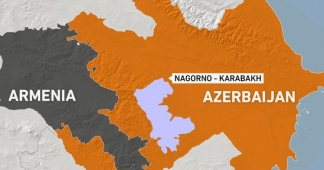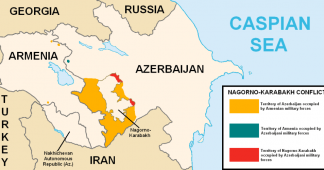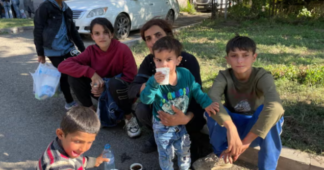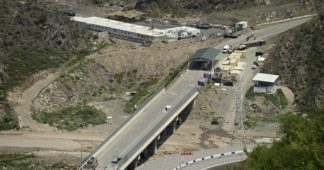From Wikipedia, the free encyclopedia
On 19–20 September 2023 Azerbaijan initiated a military offensive in the disputed Nagorno-Karabakh region which ended with the surrender of the self-declared Republic of Artsakh and the disbandment of its armed forces. Prior to this offensive, Nagorno-Karabakh, internationally recognized as part of Azerbaijan but governed and populated by ethnic Armenians, had a population of nearly 120,000. Faced with threats of genocide and ethnic cleansing by Azerbaijan, over 100,400 ethnic Armenians, nearly the entire current population of Nagorno-Karabakh,[6] had fled by the end of September 2023.[2][3] This mass displacement of people has been described by international experts as a war crime or crime against humanity.[7] While the Azerbaijani government and its officials assured residents of their safety and emphasized their intent to reintegrate the Armenian population,[8] skepticism surrounded these assurances, stemming from Azerbaijan’s established track record of authoritarianism and repression of its Armenian population.[9][10]
Background
The Nagorno-Karabakh conflict is an ethnic and territorial dispute between Armenia and Azerbaijan over the region of Nagorno-Karabakh, which is located within Azerbaijan but is predominantly inhabited by Armenians.[11]
During the Soviet era, Armenians residing in the Nagorno-Karabakh Autonomous Oblast experienced significant discrimination. The authorities of Soviet Azerbaijan suppressed Armenian culture and identity within Nagorno-Karabakh, actively encouraging Armenians to migrate out and Azerbaijanis to settle in. Despite these measures, Armenians remained the majority. In 1988, during the glasnost period, a referendum was conducted in Nagorno-Karabakh proposing its transfer to Soviet Armenia. This act was met with a series of pogroms against Armenians across Azerbaijan, before violence committed against both Armenians and Azerbaijanis occurred, leading to the outbreak of the First Nagorno-Karabakh War.[12][13]
The war resulted in the displacement of approximately 500,000 Azerbaijanis from Nagorno-Karabakh and the adjacent occupied territories as well as 186,000 from Armenia, and between 300,000 and 500,000 Armenians from Azerbaijan.[14] A subsequent conflict, the Second Nagorno-Karabakh War in 2020, caused thousands of casualties and ended with a significant Azerbaijani victory. This war allowed Azerbaijan to reclaim all the territories surrounding Nagorno-Karabakh and a third of the Nagorno-Karabakh region itself. Since the 2020 war, violations of the ceasefire in Nagorno-Karabakh and at the Armenian-Azerbaijani border have persisted, resulting in sporadic casualties.[15]
In December 2022, Azerbaijan blocked the Lachin corridor, the only road connecting Nagorno-Karabakh to Armenia that was supposed to be under the control of Russian peacekeepers, leading to shortages. In February 2023 the International Court of Justice ordered Azerbaijan to ensure free movement to Nagorno-Karabakh, ruling that the blockade posed a “real and imminent risk” to the “health and life” of Nagorno-Karabakh’s Armenian population.[16][17][18] By early September 2023 the blockade had caused supplies to all but run out; there was little medicine or fuel, while bread, a staple in the region, was rationed to one loaf per family per day.[19] Azerbaijan also sabotaged critical civilian infrastructure in the region, including gas, electricity, and Internet access.[20][21] Azerbaijan installed a border checkpoint on the corridor and, following a border shootout near the checkpoint in June 2023, tightened the blockade by not allowing any transportation to the region.[22]
International observers, including Luis Moreno Ocampo, the inaugural prosecutor of the International Criminal Court, expressed concerns that Azerbaijan’s blockade could be the onset of a genocide. Ocampo specifically stated that Azerbaijan’s actions, which included withholding essential supplies like food and medicine, appeared to be a calculated effort to inflict on the Armenian population of Nagorno-Karabakh conditions of life calculated to bring about its physical destruction.[23] In August 2023, as a direct result of the blockade, the first resident of Nagorno-Karabakh succumbed to starvation.[24] The Armenian President denounced Azerbaijan, asserting it was committing genocide by causing Armenians in Nagorno-Karabakh to starve. Similarly, Ronald Grigor Suny stated, “Baku is determined to make the Armenians’ lives impossible, starve them out, and pressure them to leave.”[25]
On 19 September 2023, Azerbaijan initiated an offensive in Nagorno-Karabakh, aiming to disarm the self-declared republic’s military.[26] The assault, lasting 24 hours, resulted in hundreds of casualties from both sides and the deaths of five Russian peacekeepers. After the Republic of Artsakh’s government agreed to surrender terms, negotiations ensued, leading Azerbaijan to eventually reopen the road to Armenia. This move provided Armenians an avenue to evacuate the region, and a significant number began departing from 24 September onward.
Flight

Prior to the Azerbaijani invasion of Nagorno-Karabakh, there were growing concerns that Azerbaijan, with a long history of Anti-Armenian sentiment, might perpetuate a genocide against the region’s Armenians. Elchin Amirbeyov, the representative of the Azerbaijani president, predicted that “a genocide may happen” if the Republic of Artsakh did not capitulate.[27][28] Echoing this concern Senator Bob Menendez, chair of the United States Senate Committee on Foreign Relations, urged for sanctions to be imposed against Azerbaijan to prevent genocide.[29][30]
In the wake of the collapse of the Nagorno-Karabakh defenses, the Lemkin Institute for Genocide Prevention issued an alert, drawing attention to the acute risk of genocide faced by Armenians in the region and highlighting the extreme levels of anti-Armenian sentiments within the Azerbaijani military. Moreover, threats and abusive messages targeting civilians, even instances of reported massacres of Armenians who chose to stay, were rampant on Azerbaijani social media channels.[31] In a concurrent announcement, Genocide Watch also sounded an alert, categorization the situation as Stage 9 within their ten stages of genocide framework – Extermination.[32]
While the Azerbaijani government and its officials assured residents of their safety and emphasized their intent to reintegrate the Armenian population,[8] skepticism surrounded these assurances, stemming from Azerbaijan’s established track record of authoritarianism and repression of its Armenian population.[33][34]
Timeline
On 24 September, despite an ongoing blockade, Azerbaijan permitted Armenian civilians to use the Lachin corridor for one-way travel to Armenia.[35] The same day, as fears of genocide, ethnic cleansing, and persecution surged, the initial group of refugees arrived in Armenia via the Kornidzor border post.[36][37] By day’s end,[clarification needed] as reported by the Armenian government, 1,050 refugees had made their way to safety.[38] Word of the passage spread, leading to a mass exodus. [39][40]
By 25 September,[clarification needed] according to the Armenian government, 6,500 refugees had arrived from Nagorno-Karabakh.[41] After enduring months of scarce fuel supply while under blockade, the arrival of a fuel shipment gave residents the opportunity to refuel their vehicles for the journey to Armenia, and on 25 September, petrol stations in Stepanakert began distributing fuel at no cost to those evacuating to Armenia.[42] However, amidst extensive lines at a fuel station in Berkadzor an underground 50-ton fuel tank exploded, leading to the death of at least 170 individuals and injuring hundreds of others.[43] Most of the victims were queueing to obtain fuel for their vehicles while on their way to Armenia.[44] Victims with various degrees of burns were treated in the Republican Medical Center of Artsakh, facilities of the Arevik community organization, medical facilities in Ivanyan, and the medical station of Russian peacekeepers.[45] The Presidential Administration of Azerbaijan said it sent an ambulance carrying medical supplies.[46][47] 142 of the injured were later brought to Armenia.[48]
By 26 September, the Armenian government said at least 28,000 people had fled Nagorno-Karabakh, equivalent to a quarter of the region’s population.[49]
By 27 September, Armenian authorities reported that over 50,000 refugees from Nagorno-Karabakh, over 40% of the region’s population, had left for Armenia, including 17,000 children.[50] In separate events on 27 September, Ruben Vardanyan, an former high-level Artsakh government official and a prominent businessman, was apprehended by Azerbaijani forces just as he was poised to enter Armenia,[51] and civilian accounts from the village of Vaghuhas reported that Azerbaijani soldiers had entered the village and, discharging their firearms into the air, demanded the residents flee.[52][53]
By 28 September, the tally of arrivals in Armenia surpassed 65,000, accounting for over half of the Nagorno-Karabakh‘s total population.[54] The evacuation route from Stepanakert to Armenia had been clogged for days, with many forced to sleep in their cars overnight.[55] What typically is a 2-hour drive transformed into a staggering 30-hour journey for many evacuees.[55]
By 29 September, the number of refugees had reached 97,700, representing over 80% of Nagorno-Karabakh’s total population.[3] Refugees reported spending days in the evacuation queue and moving forward only a few hundred meters a day. [56] Armenian Health Minister Anahit Avanesian said some refugees died in transit due to exhaustion brought about by malnutrition, the lack of medicines and the travel time which took up to 40 hours.[48]
By 30 September, the number of refugees had reached 100,400.[2] On 2 October, the last bus carrying refugees composed of those with serious illnesses or mobility issues entered Armenia. The Armenian government stated that 100,514 of the estimated 120,000 population of Nagorno-Karabakh had been displaced as of 2 October,[5] reaching 100,617 by noon of 3 October.[1] The UN mission who was tasked with visiting the region, heard from interlocutors on 1 October that only 50 to 1000 Armenians were left in the entire Karabakh region.[57]
Armenian support
To aid in the evacuation, 46 buses, usually designated for public transport in Yerevan, transported 1,560 individuals from Stepanakert to Goris on 28 September.[58] Armenia also sent 23 ambulances to Artsakh accompanied by specialists and the Red Cross,[59] which returned transporting 23 severely injured people from Artsakh to Armenia.[60]
In Armenia, the theatre in the city of Goris was converted into a base for the Red Cross to accommodate refugees.[61] A secondary hub was later opened in Vayk.[62]
Genocide and ethnic cleansing warnings
Various political analysts, along with residents of Nagorno-Karabakh, believe that Azerbaijan’s primary objective for the offensive is ethnic cleansing.[63][64] Luis Moreno Ocampo, the inaugural Prosecutor of the International Criminal Court, cautioned that conditions akin to another Armenian genocide were developing, stating that Azerbaijan’s blockade violated Article II c of the 1948 Genocide Convention, by “deliberately inflicting on [a] group conditions of life calculated to bring about its physical destruction in whole or in part”, and that the invasion further violated Article II a and Article II b. He warned that the international community’s inertia could embolden Azerbaijan, making them believe there would be no significant repercussions for committing genocide. Ocampo also countered Aliyev’s denial of seeking ethnic cleansing, noting that Aliyev often labeled Armenia as “Western Azerbaijan” and proclaimed that “present-day Armenia is our land”.[17] Samantha Power, the top U.S. humanitarian aid official and a former genocide scholar, declined to use the term “genocide”, nevertheless, she went on to say that testimony was already being gathered “from people who have fled violence, deprivation, and with the fear of living under the government of Azerbaijan.”[65] International legal experts, Priya Pillai and Melanie O’Brien, a visiting professor at the University of Minnesota and president of the International Association of Genocide Scholars, described this mass displacement as either a war crime or crime against humanity perpetrated by Azerbaijan.[7] This characterization is based on the created coercive environment, first through the blockade and subsequently the invasion, leading to the potential genocidal destruction of the Artsakh Armenians’ distinct identity.[7]
Accusations of ethnic cleansing by Azerbaijan have been leveled by Nikol Pashinyan, the Prime Minister of Armenia,[66] the European Parliament,[67] the Cypriot Ministry of Foreign Affairs,[68] and the Israeli newspaper Haaretz among others.[69] On 21 September 2023, however, Pashinyan stated that “at this moment, our assessment is that there is no direct threat to the civilian population of Nagorno Karabakh” and that around 1200–1300 citizens and children were sheltered in the headquarters of the Russian peacekeeping forces.[70]
Azerbaijani officials have rejected war crimes accusations and responded by urging Armenians to stay in the region.[8][71] Sources reported that Azerbaijan had reissued a map renaming a street in Stepanakert, the capital of Nagorno-Karabakh, after one of the main instigators of the Armenian genocide Enver Pasha.[72][73] Azerbaijan disputed this during a case at the International Court of Justice, saying the “No streets in Khankandi have been renamed”.[74] The United Nations Refugee Agency representative in Armenia said there were no recorded incidents or cases of mistreatment against people on the move, and in response to questions from the media, they said they couldn’t comment on whether this constituted ethnic cleansing and that they were viewed it as a refugee situation.[75] While the USAID representative said that they were aware of “troubling reports of violence against civilians”, and that testimony was being gathered from those who had fled “violence, deprivation, and with the fear of living under the government of Azerbaijan”.[75][65] US State Department declined to comment on the allegations of ethnic cleansing as claimed by Armenians, but emphasized that they are taking these allegations seriously.[76] President of the European Council Charles Michel refrained from characterizing the forced exodus of the Nagorno-Karabakh population as an attempt at ethnic cleansing.[77] However, on October 5, the European Parliament filed a joint motion for a resolution stating that the flight of Armenians from Karabakh “amounts to ethnic cleansing” and that Azerbaijan’s military offensive “represents a gross violation of human rights and international law.”[78]
International response
In response to the humanitarian crisis a number of countries pledged aid to help Armenian refugees, including Iran which donated 50 tons of aid to forcibly displaced Artsakh residents,[79] the UK with £1m and the EU with a pledge of €5m.[80][81] The chief of USAID Samantha Power arrived in Armenia together with US State Department Acting Assistant Secretary for Europe and Eurasian Affairs Yuri Kim to visit the affected people and pledged $11.5m in humanitarian assistance. Power said that “many of those who had arrived were suffering from ‘severe malnutrition,’ according to doctors at the scene”.[82] On 28 September, USAID sent a Disaster Assistance Response Team to the region to help coordinate the U.S. humanitarian response.[83] Cyprus said it was ready to provide humanitarian assistance to displaced Armenians and that it was considering ways to host a number of Armenian refugees if necessary.[68]
The United Nations in Azerbaijan, led by the UN Resident Coordinator in Azerbaijan Vladanka Andreeva, sent a mission to Nagorno-Karabakh to address humanitarian needs on 1 October. While visiting Stepanakert, the team claimed to have found no evidence of damage to public infrastructure in the areas it visited. The mission saw that the Azerbaijani government was preparing for the resumption of health services and some utilities.[84] The mission reportedly “was struck by the sudden manner in which the local population left their homes”. It was reported to the team that between 50 and 1,000 ethnic Armenians remain in the region. It encountered no civilian vehicles on the Lachin road to the border crossing used by the refugees. The mission also had limited access to rural areas.[84][85] The mission was criticized for failing to mention the numerous casualties and injuries among Armenian civilians, the targeting of civilian infrastructure by Azerbaijan, and blockade of Nagorno-Karabakh by Azerbaijan over the previous nine months along with the humanitarian crisis it caused.[86][87][88]
Armenia requested the International Court of Justice to reaffirm its February 2023 ruling ordering Azerbaijan to ensure free passage through the Lachin corridor, and to “refrain from all actions directly or indirectly aimed at displacing the remaining ethnic Armenians from the region”.[89]
Continue reading at en.wikipedia.org
We remind our readers that publication of articles on our site does not mean that we agree with what is written. Our policy is to publish anything which we consider of interest, so as to assist our readers in forming their opinions. Sometimes we even publish articles with which we totally disagree, since we believe it is important for our readers to be informed on as wide a spectrum of views as possible.










